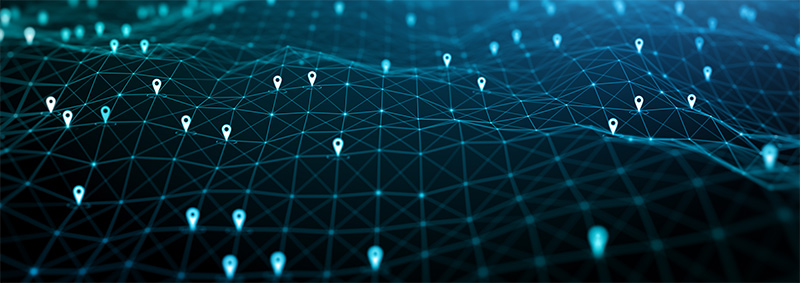22
Jan
Location Analytics: Enhancing Business insights

The businesses of today are fast-paced and spread across multiple locations. With such dynamics, businesses not just need data analytics but location analytics to keep up with the business pace at various locations. With remote operations and traveling constraints, it is even more critical for businesses to have precise insights that provide operational view up to the level of zip codes. Location analytics is becoming a key component of analytics tools as it communicates detailed visual insights via maps to the business users. It is helping companies to not just outmaneuver the previous challenges but also to propagate insights much better now.
What is location analytics?
Location analytics is the ability to combine business data with geographic data and analyze it to generate powerful insights. Businesses can understand data related to transactions, people, events, and more through location perspective and get visual insight in a rather plain set of data.
This can further contextualize insights for business users. Location analytics can be applied to both real-time and historic geographic data. Real-time location analytics can especially be important for the couriers and the shipping industry where live tracking of the packages, delivery vehicles, and distributors, needs to be done to streamline their work. Also, it could play a significant role in the military for tracking troops and other essentials and make data-driven decisions.
While the historic location analytics has even wider applications ranging from retail to disaster management. Retailers operating across multiple locations can correlate consumer behavior, sales, and all other important factors with the exact location. They get an in-depth understanding of what is the consumers’ behavior at one specific location and how campaigns and other services can be optimized to increase sales and consumer satisfaction. In the case of disaster management, basis the historic data, the authorities can ascertain which areas are more prone to what type of disasters and climate conditions and take preventive actions to stop the situation from escalating.
Benefits:
- Location analytics brings in the much-needed visual element in the lat-long data, enabling everyone right from analysts to the business users to understand it quickly.
- It helps in optimizing the business ROI by combining the business data with location data and providing accurate insights enabling users to make customized strategies for various locations. For example, leaders can identify which product is selling well everywhere except a few locations and drive engaging marketing campaigns for those places. This saves time, resources, and efforts in identifying issues, opportunities, and more. It enables marketers and the sales team to make targeted strategies by associating all the consumer insights with a location.
- Location analytics helps the business users connect the often-plain insights to the actual world by depicting them via maps and connecting each set of insights to a specific location coordinate.
- With this, analysts and business users can altogether skip learning how GIS tools operate, and can directly create intuitive visualizations on maps and ease the process of insight generation and consumption.
- It can significantly impact the way budgeting is done and help reduce expenses and prevent revenue leakages. With location analytics, a heatmap of spending and revenue can be plotted for comparative analysis. This can point out locations or areas where there are performance issues and revenues are not as expected. They can drill down to identify the challenges, find out relevant correlations between the national and local data.
- It also enables cost-saving and streamlining operations for supply chain and inventory management. It can ease the real-time routing, citing inventory stock placements, etc.
- Location analytics can also help enhance customer services and their overall satisfaction level. Companies can easily associate customer behavior, demands, issues, and expectations with their respective locations and provide personalized offerings, targeting these location-specific challenges.
- Its benefits are simply not limited to location-based consumer behavior and sales analysis. It can help the retail chains to make data-driven decisions on their store expansion strategy. It can take multiple internal and external factors into account to provide insights on potential best locations. It can also equip regional teams to derive needed campaigns right from customer acquisition, engagement to loyalty marketing.
- National and International CPG brands can also utilize location analytics to analyze internal sales and consumer data to determine locations where they can launch certain new products first and also identify locations that are not performing up to the mark to run campaigns or shut.
- The real estate industry can also take location analytics’ advantage by predicting top potential locations or properties to invest in based on past data regarding sales, appraisal, location, and more enhancing ROI and enabling smarter decisions.
- The automobile industry can leverage this to target the right audience based on their previous interactions and interest shown and identify the most appropriate events based on locations and sponsor them.
- The food and restaurant industry can also improve its marketing efforts, understand customers better as per their location preference, and more and improve ROI by targeting the right audience and improving engagement.
As per a report, by 2021 the location analytics market is expected to reach $16.34 billion in valuation by experiencing a compound annual growth rate of 17.6%. This exemplary growth rate can be attributed to increased utilization of IoT devices and the resultant exponential data collection. Right from retail store locations based on pin codes to IP-addressed device locations, companies can track important location insights in real-time and make quick decisions. This not just provides companies a competitive advantage but also helps them deliver excellent customer experience. It is needless to say that location analytics is a must-have in any company’s analytics arsenal.

